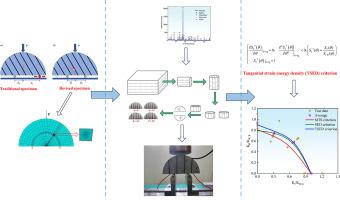A novel specimen for mixed-mode fracture testing of anisotropic rocks
IF 9.4
1区 工程技术
Q1 ENGINEERING, MECHANICAL
International Journal of Mechanical Sciences
Pub Date : 2025-09-17
DOI:10.1016/j.ijmecsci.2025.110846
引用次数: 0
Abstract
This study introduces a novel Semi-Circular Bend (SCB) specimen to overcome the inherent coupling between geometric constraints and material response in traditional fracture tests on layered rocks. The novel design fixes both the support span and bedding orientation while independently varying the prefabricated crack inclination angle, enabling controlled mixed-mode I/II fracture conditions. This approach enables, for the first time, a precise investigation of crack trajectory influence under constant geometric constraints. A quantitative analysis was performed by combining parametric finite element analysis and three-point bending experiments on slate samples. The results demonstrate that the fracture toughness of the layered rock exhibits a nonlinear evolution with the increasing crack angle β. The dominant fracture mechanism shifts from tensile to shear failure as β increases. While existing anisotropic fracture criteria like the Maximum Tangential Stress (MTS) and Minimum Strain Energy Density (SED) are accurate under tensile loading, they significantly underestimate the material's toughness in shear-dominated regimes. We further propose and validate a Tangential Strain Energy Density (TSED) criterion, which shows superior accuracy, especially under Mode II conditions. This work provides a robust experimental-theoretical framework for assessing fracture behavior in bedded rock masses with natural cracks, with direct implications for tunnel and slope stability.

一种用于各向异性岩石混合模式断裂试验的新型试样
为了克服传统层状岩石断裂试验中几何约束和材料响应之间固有的耦合,本研究引入了一种新型的半圆弯曲试件。这种新颖的设计既可以固定支撑跨度和层理方向,又可以独立改变预制裂缝倾角,从而实现可控制的I/II混合模式断裂条件。该方法首次实现了在恒定几何约束下裂纹轨迹影响的精确研究。采用参数化有限元分析和三点弯曲试验相结合的方法对板岩试样进行了定量分析。结果表明:层状岩石的断裂韧性随裂纹角β的增大呈非线性演化;随着β的增大,主要断裂机制由拉伸破坏向剪切破坏转变。虽然现有的各向异性断裂标准,如最大切向应力(MTS)和最小应变能密度(SED)在拉伸载荷下是准确的,但它们明显低估了材料在剪切主导下的韧性。我们进一步提出并验证了切向应变能密度(TSED)准则,该准则具有较高的精度,特别是在模态II条件下。这项工作为评估具有天然裂缝的层状岩体的断裂行为提供了一个强大的实验-理论框架,对隧道和边坡的稳定性具有直接意义。
本文章由计算机程序翻译,如有差异,请以英文原文为准。
求助全文
约1分钟内获得全文
求助全文
来源期刊

International Journal of Mechanical Sciences
工程技术-工程:机械
CiteScore
12.80
自引率
17.80%
发文量
769
审稿时长
19 days
期刊介绍:
The International Journal of Mechanical Sciences (IJMS) serves as a global platform for the publication and dissemination of original research that contributes to a deeper scientific understanding of the fundamental disciplines within mechanical, civil, and material engineering.
The primary focus of IJMS is to showcase innovative and ground-breaking work that utilizes analytical and computational modeling techniques, such as Finite Element Method (FEM), Boundary Element Method (BEM), and mesh-free methods, among others. These modeling methods are applied to diverse fields including rigid-body mechanics (e.g., dynamics, vibration, stability), structural mechanics, metal forming, advanced materials (e.g., metals, composites, cellular, smart) behavior and applications, impact mechanics, strain localization, and other nonlinear effects (e.g., large deflections, plasticity, fracture).
Additionally, IJMS covers the realms of fluid mechanics (both external and internal flows), tribology, thermodynamics, and materials processing. These subjects collectively form the core of the journal's content.
In summary, IJMS provides a prestigious platform for researchers to present their original contributions, shedding light on analytical and computational modeling methods in various areas of mechanical engineering, as well as exploring the behavior and application of advanced materials, fluid mechanics, thermodynamics, and materials processing.
 求助内容:
求助内容: 应助结果提醒方式:
应助结果提醒方式:


